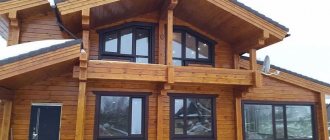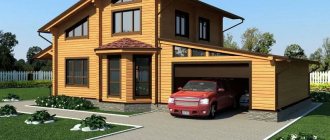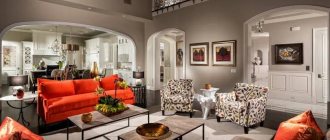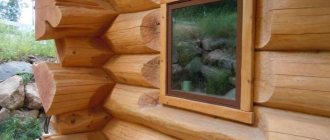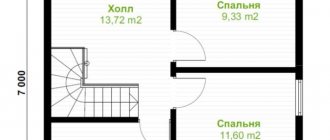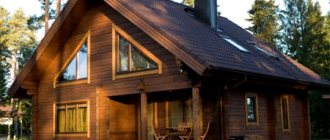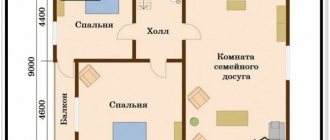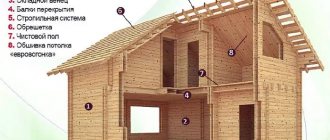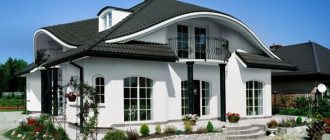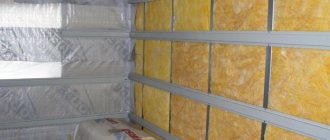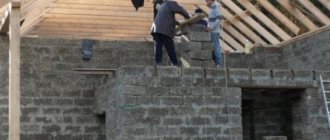Due to the speed of construction, country houses using Canadian technology are widely in demand on the country real estate market, especially since they can be simply ordered on a turnkey basis. This construction method is very common in Canada, which is what gives houses built using this technology their name. Well, since the climatic conditions of Canada are close to domestic ones, the methods of constructing suburban housing developed and tested in this country are relevant for Russian buyers. What houses can look like using Canadian technology: projects, prices, photos in our article.
A small frame house built using Canadian technology Source karkas-nsk.ru
Canadian houses: a little history
The first frame buildings were known in Europe during the early Middle Ages. In those days, the structure was based on a system of posts and beams with braces located diagonally. The space between the parts of this frame structure was filled with stone, bricks or clay.
Colonists who came to Canada and the United States from Europe used this technology, which allowed them to create houses at any time of the year in a short time. To protect against the harsh weather conditions of Canada, the walls of the houses were covered with boards on the outside and inside, and the voids were filled with any available material. Most often a mixture of clay, straw, sand and stone was used.
Houses in old European cities are “distant ancestors” of modern frame technology Source nkkconsult.ru
Thus, the basis for creating houses using Canadian technology even in those days was the prototype of insulated panels, with the help of which it was possible to build a high-quality warm house in the shortest possible time. Modern technology of “Canadian houses”, adapted for harsh climatic conditions, has a number of advantages and disadvantages.
Options for layouts and projects
All such households, starting from the middle of the last century, have been built with complex architecture :
- multi-storey;
- with warm attics and a warm garage;
- verandas;
- terraces and balconies.
Premises on the 1st floor, as a rule, have high ceilings up to 3 m, large square, rectangular or arched windows. The first floor is a guest floor, there is a spacious hall, living room and dining room. The second floor is used for living rooms, there is also a nursery and an office.
Furnaces are usually located in basements, and air heating is provided throughout the house through a duct system. A general air conditioning and ventilation system is also installed. There is a separate laundry area in the basement or utility room on the first floor.
Exterior finishes in most parts of Canada are imitation brick, a material bonded to the outside of the wood frame. Roofs are often covered with asphalt or cedar shingles; recently, metal tiles have become more popular.
Advantages of modern Canadian houses
A frame house using this technology is built from panels covered with OSB (a material made from wood chips impregnated with polymer resins) and insulated with polystyrene foam. The dimensions of the panels are selected individually, taking into account the size of the finished building. Insulated panels are ready-made wall elements that are fixed on a pre-built foundation. After this, the installation of floors, roofs, as well as doors and windows occurs.
- The main advantage of the technology is the speed and ease of building a house. Installation work does not require the involvement of specialized equipment and a large team of builders; on average, a house is erected within 2-3 months.
- A frame structure using Canadian technology will cost about half the price of a full-fledged brick house, while the functional characteristics of both buildings are similar.
Facing brick in the design of a frame house Source karkasblog.ru
- Lightweight panels do not require the construction of a powerful foundation, so they can be built on areas with any terrain.
- Expanded polystyrene, filling the space between the panels, has high insulating properties. Therefore, the finished building does not require additional sound insulation and insulation.
Unlike dwellings made from beams or logs, Canadian wooden houses allow installation of utilities inside the panels themselves. Thus, finished living spaces look more aesthetically pleasing, and less time and effort is spent on installation.
Stages of building a frame house
The construction site is leveled, the fertile layer of soil is removed, and stored. They dig a pit below the soil freezing zone (for central Russia 1.50-1.80 m ). A monolithic slab is poured around the perimeter of the external walls. Slab section dimensions: height 150 mm width 300 mm . Reinforcement is installed along the entire length of the slab. In the diagram it consists of two rods. Shallow slabs are poured under the internal walls and beam ceilings, then, during the installation of the basement floor, timber columns are installed on them.
Foundation for a residential building
After checking the horizontal level of the base, diagonals and right angles, proceed to tying the beds (board 150x50 mm ). Along the perimeter of the base, in the center, at a distance of 1-2 meters, anchor pins are fixed for fastening the beds. The board is laid out on top of the plinth, cut to size, then the places for drilling holes for the studs are marked. A rolled glass wool gasket is placed between the surface of the plinth and the bed. The beds are secured with nuts and washers to the base (see diagram above).
Even at the stage of construction of the plinth, pockets were made in advance in places where the floor beams were supported. Opposite them, slots are made in the beds to insert the ends of the beams. The cord is pulled along the axis of the beams and the height of each of the intermediate supports is noted. The distances are written down in a notebook, and then support posts are prepared from 100x100 mm and attached to the base of the slabs. The distance between the posts is no more than 2 meters . The racks are fastened with 4 80 mm , 2 on each side.
Attaching the support post to the base of the slab
100x100 mm timber are laid on them . They are attached in the same way, only the nail is driven at an angle into the beam. At this stage, the alignment of the beams is regularly checked. Eliminate defects immediately: before moving on to the next assembly of the frame element, check the location of the parts with the drawing.
Assembling the floor joists
First, a tied beam is nailed around the perimeter of the bed - a 150x50 mm . It is placed on its edge on the edge of the bed and nailed to it with 90 mm , first at the end, and then. every 40 cm . Having completed the external piping, markings are made for the floor joists, which will lie across the floor beams at intervals of 40 cm . Prepare in advance the required number of lags and spacers 40 cm for the rigidity of the structure and the specified interval between the lags. The logs are laid out on the floor beams. The ends of the lags are placed edgewise on the bed and secured with 2 nails at the end and a nail in the bed on both sides. The logs are fastened together with an overlap of at least 10 cm above the floor beam.
Splicing floor joists
First, 2 nails are driven into the lintel, then 2 nails on both sides into the joints and one nail at an angle into the beam. The logs are leveled, and then they begin to lay the sheet material on the rough covering (multilayer plywood, OSB board). But first, they lay utility lines inside the base.
Laying floor sheets
The sheathing is done with 2 cm tongue-and-groove plywood. We mark the first row. Apply glue (liquid nails) in places where they are pressed against the joists. This prevents squeaking when walking. We nail 70 mm the joists at a distance of 10 cm around the perimeter, 15 cm inside the building and 30 cm along the joists. First, apply glue (liquid nails) in places where they are pressed against the joists.
According to technology, this prevents squeaking when walking. In the places where the sheets join, leave a gap equal to the thickness of the nail. The second and subsequent rows are laid in a checkerboard pattern.
Assembling the wall frame
We prepare the frame elements of the external walls according to the dimensions specified in the project.
Working drawing of the basement floor
The drawing shows the places where reinforcement of the frame is required: window and door openings. We make markings on the floor of the walls of the first floor, marking the places where the elements meet. Let's start assembling the outer walls. The dimensions are transferred to the floor and assembly begins. You will need knowledge of the technology for assembling openings. The diagram shows window and door openings.
The distance between the frame posts is 40 cm . This gap is necessary for laying insulation between them.
Video - Assembly and lifting of frame walls using Canadian technology (6x8 frame house)
Joining the corners of adjacent walls
Before raising the walls, tie the corners at the junction. The design documentation contains a drawing describing the technological operation. Here are 2 ways of strapping: on the left from 3 boards 150x50 mm , on the right from 3 boards 150x50 mm and one board 100x50 mm .
Docking methods
The second method is preferable, since the cold bridge is insulated with insulation. Internal adjacent walls are connected in three boards; here there is no cold bridge. After raising the walls, they are leveled, then markings are prepared for installing floor beams.
Ceiling and interfloor coverings
One-story frame houses are designed with a cold attic or a warm residential attic. Guided by the project, floor beams are prepared. The pitch of the beams is 40 cm . When drawing up a project, engineers calculate the loads on the beams. The beams are laid on the top frame of the walls, mounted according to the instructions set out in the project. To understand how the unit is arranged: wall, beam, rafters, consider the layout.
Rafter system attachment points
The gable beam is placed flat on the top frame. At the point where it abuts the wall, a groove is cut into the beam for the rafter board. Pay attention to the angle of inclination. In Canada, some departments require a ratio of 4 inches to 12 - 18.5 degrees . In any case, follow the design and cut the corners correctly. In snowy regions, a slope of 40 degrees . It is better to place the rafter spacers perpendicularly, then you will not have to plan the protruding part.
Floor beams are also the floor joists of the attic or attic. Installation in increments of 40 cm is needed for laying thermal insulation. When all the beams are in place, check the fastening locations again using the drawing. Immediately after installing the beams, it is recommended to install a rafter system and mount the roof. So protect the building from bad weather.
Rafter system and roof
This element of the house experiences wind and snow loads , so the roof slope is regulated for each department. Roof shapes may vary. For frame houses, the gable form is the most common because it is easy to manufacture, install, and costs less. An attic room or a cold attic is built underneath it.
We will not consider other forms for now. It is important to understand how to properly sheathe the rafter system so that heat does not escape through the roof and it is not hot in the summer. The rafter boards are prepared at the bottom, then served on top and laid out in marked places. Start installation.
Installation of rafters
A control post is nailed to the center of the façade so that the ridge runs along the central axis of the roof. The stand is auxiliary; it makes it easy to control the vertical plane. First, the rafters are mounted from the front walls, then between them, where the vertex of the triangle is formed, a ridge is laid - a 200x50 mm . Supports are installed every 3 meters. Additionally strengthened with bevels. The remaining rafters are installed.
Note! The attic space is non-residential and is usually used for storing things. Sometimes a ventilation system is installed in the attic. It is necessary for frame buildings.
If the rafters are long, then they will bend under the weight of the snow, so designers recommend installing an additional supporting structure in the place of possible deflection: a long board 100x50 mm is nailed edgewise to the rafters, and then under it, as under a ridge, support posts are placed in increments of 3 m .
Front boards and eaves of a gable roof
The construction of the rafter system is completed with the installation of cornices and frontal boards (finishing boards of the pediment). Let's look at how this is done on the layout.
Installation of cornice and front board
The ends of the rafters are cut along a line with a offset of 30 cm , then a cornice is nailed into the end with a downward shift of 2.5 cm so that the OSB sheets lie freely on the rafter board. The front board is nailed on the gable side. Pay attention to the consoles; they have a projection at the level of the ridge. The front board is nailed to the ridge with two nails, then one nail to each console. You probably noticed the cuts in the rafter board in the previous photo. They are designed for a 50x50 mm , which is a console. The front board and cornice are joined at an angle of 45 degrees .
It's time to lay OSB sheets on the rafters. Lay from the side of the cornice. The principle is the same as for flooring. Mark the edge of the sheet with a cord and lay the first row. The second row is laid in a checkerboard pattern, cutting the first sheet in half. Then the house is covered with metal tiles or other material specified in the project. Now we need to finish the engineering part of the project - piping communications. Then work on insulation and finishing continues.
Disadvantages of building a house using Canadian technology
Despite many obvious advantages, houses using Canadian technology have a number of features and limitations, due to which they are not suitable for all owners of suburban areas. The main feature of the technology is the limitations on the dimensions of the finished building. The height of each floor should not exceed 3 meters, there can be a maximum of 3.
The compactness of Canadian houses does not affect their functionality and pleasant appearance Source avantage-dom.ru
The environmental friendliness of the finished building may raise questions due to the abundance of polymer resins impregnating the product. However, this is a question of the integrity of the manufacturers of such structures - if the panels are made in compliance with the technology, then they comply with all environmental safety standards.
The characteristics of a finished residential building, in addition to the quality of the material, are also determined by the professionalism of the team of workers. If the contractor’s integrity combines with high-quality components and finishing according to all the rules, then a Canadian house is a comfortable and durable home.
Canadian features
Canadian construction legislation is very strictly regulated. The technologies, materials used and their manufacturers are spelled out once and for all. It is possible to prove the suitability of other building materials, but this is a long and unprofitable job. References to the experience of other countries will not work.
Canadian building codes are not universal. Different provinces have different regulations.
In Canada, the construction of wooden houses with 6 floors is allowed.
Not a Canadian project, a US one. Wooden frame 36 meters high. "475 West 18th", New York.
The methodology for calculating the energy efficiency of houses is different from the Russian one. The essential thing is that there are heat conservation criteria that cannot be violated. In Ontario, 100 mm of polystyrene foam on top of 150 mm of mineral wool is the norm.
Canadian SNiPs do not exist in the public domain. This is the intellectual property of the developers. You must pay to access any document.
Foundation
A common option for building frame structures is a strip foundation, which is a concrete structure immersed in the ground by about 50 cm, the height above the ground is 20-30 cm. With correct calculations, a strip foundation allows you to erect a residential building on various types of soil, including swampy and mobile ones. The main disadvantage of such a foundation is the inability to carry out a global redevelopment of the house over time.
Ready-made strip-column foundation “in cross-section” Source emupauto.ru
Screw foundations can be sunk to a considerable depth, which makes it possible to use them to create a foundation for a house on difficult soils. The main disadvantage is that noticeable shrinkage of the structure is likely, especially if there are errors in calculations or violation of technology. As a result, finishing work will have to wait for some time after completion of construction work. In addition, there is no need to think about either the basement or the ground floor in such a house.
Screw foundation made of metal piles Source 72.ru
The most reliable option is a slab foundation, which is a flat reinforced concrete “pillow” on which the structure is erected. Due to its high cost, it is usually not used when building prefabricated houses using Canadian technology, but on sandstone or when there is an abundance of groundwater, this may be the only possible option.
Schematic diagram of creating a slab foundation Source profundamenti.ru
Most often, the cost of the foundation is calculated separately from other work on the construction of a frame house. Experienced specialists will help the customer choose the optimal type of foundation depending on the characteristics of the building and the surface on which it will be built.
What does the concept mean?
By this term, experts understand a prefabricated structure with a completion period of 2 to 5 months .
The basis of the house is a wooden frame formed from solid wall structures. Houses can be produced both for permanent residence and for seasonal residence in the form of summer country houses.
The difference between them is in the thickness of the insulation; in the first case, a reinforced layer is installed in the wall - from 200 mm, in the second - no higher than 150 mm.
In addition, permanent residential buildings for permanent residence are characterized by a significantly high level of life support . Such a household must have reliable autonomous or centralized sources: electricity, water supply, sewerage and heating.
The issue of mandatory gasification in the regulatory plan for houses with permanent and seasonal residence is not fixed; everything will depend on the availability of main gas pipelines in the development area.
to erect such buildings in any place, on any soil, without fear of subsidence of load-bearing structures. Such buildings do not need a reinforced foundation, since the weight of wall structures and roofs is small compared to stone structures.
Frame houses in Canada are built only by certified teams; the work of each stage of construction is checked by state supervision; without its visa, the house cannot be put into operation. This ensures high quality houses and long standard service life - more than 100 years.
There are two options for constructing Canadian buildings using frame technology - on site, on site and in a factory using modern CNC machining equipment. Canadian developers, according to statistics, build frame houses on the construction site in 89% of cases, and only in 11% of cases are they prefabricated. This is due to the significant difference in cost of these construction options.
Canadian prices for the construction of frame housing construction: assembly of factory-made elements on the construction site - $1,800 per 1 m2; modular frame-panel buildings, houses 18x4.9 m - $2,500 per 1 m2; ready-made factory house with utilities - $3,500 or more per 1 m2.
Book and film by Larry Hohn "The Very Efficient Carpenter"
Reliable and easy-to-install SIP panels, which are easy to install without additional construction equipment, allow you to create a home with your own hands.
The book and film by carpenter Larry Hohn, “The Very Efficient Carpenter,” describes in detail the process of building a frame house using Canadian technology. Each chapter of the book and episode of the film is devoted to the components of the house: floors, walls, roof, as well as self-construction of the stairs. At the beginning of the video, the process of calculating the required amount of building materials is described, the necessary tools are mentioned, and the progress of the work itself is shown in detail.
Eventually
Classic Canadian or American frames are rarely found in domestic designs - why choose one when you can mix. The platform simplifies further work and assembly of walls, but instead of double strapping, a crossbar can be used, and instead of a windproof film, MDVP is increasingly being installed. Also, UVF or USHP becomes an excellent basis for a two-story Canadian frame and the absence of a platform does not bother anyone. But in any embodiment, a detailed design, high-quality materials, sufficient insulation and a wall cake with all membranes are required.
What to assemble the frame from is discussed in one of the thematic articles. For more details on how to avoid RSC, see the material on how not to build frame houses. In the video there is a review of a Finnish frame house.
Subscribe to our Telegram channelExclusive posts every week
Video description
Larry Hohn's film:
The Work of a Master shows that the construction of a durable building requires not only experience and skill, but also the selection of materials with the necessary technical characteristics. Unfortunately, when creating a home, “there are no small details.” For example, an incorrectly created foundation or a violation of roof insulation technology leads to premature destruction of the house.
The process of constructing a frame house Source 1asku.ru
History of appearance
Canadian-style houses did not originate in Canada at all, but in Europe and then in the USA. Despite the fact that the technology of log cabins that are built in Russia was well known to the Americans, they do not have such frosts to build heavy houses that require heavy stone foundations.
Considering that by the end of the 19th century, the woodworking industry in the United States had developed so much that making timber was not a difficult task, and single-story America, with the arrival of emigrants, was being upset at a rapid pace - frame houses began to grow like mushrooms.
They were cheap and quickly built on almost any soil. Poor emigrants from the Old World could afford it.
This has led to 80% of low-rise America living in frame houses. Both poor and rich. And frame houses can be both simple and prestigious.
By the way, some frame houses in North America, which are more than 200 years old, are recognized as architectural monuments. Tourists are taken to them, and they continue to function as usual, as before.
Subsequently, this construction technology migrated to Canada. After World War II, the need arose to provide returning soldiers, emigrants, and refugees with housing. Frame houses were the simplest solution.
Canadian construction companies quickly figured out where they could make money and developed not only a lot of house designs, but also began supplying ready-made components for quickly assembling a house. Hence the name - Canadian houses.
Although in the Soviet Union such houses were always called Finnish, and they were supplied from Finland.
Consequences of technological errors during the construction of a building
The main mistake when building a house is inappropriate savings. SIP panels are based on wood, so it is strongly recommended to pay attention to their quality. Damp, improperly dried or rotten wood means future gaps in the walls, drafts and rapid destruction of the house.
All joints in the finished structure must be adjacent to each other as closely as possible; all gaps must be treated with sealant and construction foam. This will avoid unnecessary “cold bridges” (places of penetration of rain and wind), which contribute to the destruction of the house.
A finished house made of SIP panels, treated with sealant: the seams are tightly adjacent to each other Source tutknow.ru
Tightly fitting panels require the installation of additional ventilation, as well as the use of artificial gaps. Before starting work, you should ask the builders exactly how the house will be ventilated.
The quality of the factory-made panels themselves should be checked before installing the building. As a rule, high-quality SIP panels have smooth edges, regular shape and uniform color. It is strongly recommended not to purchase cheap Chinese-made stoves that are not adapted to harsh weather conditions.
Edwards Gardens
After all the material for the article was filmed, and I smiled a lot from the memories of five years ago, I had to move on. I’ll tell you where we were going later. But along the way, quite by accident, we came across a park called Edwards Gardens. I will not once again write admiring comments about the newly-seen park. It seems that I have ceased to be surprised at how often they are found here, and how beautiful they look. Let me just say that it’s very beautiful there.
